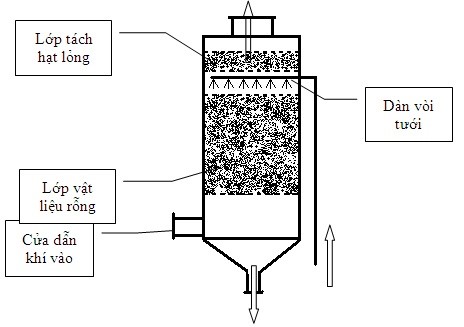To deeply understand exhaust gas treatment methods, we don’t just stop at one or two methods. The more technologies we must grasp and understand, the more suitable choices we will have for the project. In this article we will mention the absorption method in exhaust gas treatment.
This method is effective and has relatively low investment costs.
Method content includes:
Concept of exhaust gas treatment by absorption method
Exhaust gas absorption is a method of using liquids and solids as materials to absorb toxic gases from the factory’s production process.
This is the process of transferring toxic gases that need to be treated into the liquid phase. Thanks to the dissolution process, they come into contact with each other.
Absorption methods in exhaust gas treatment
The absorption process is widely used to dehumidify the air to remove odor-causing substances, solvent vapors, colorants, and water-soluble ions.
There are 2 absorption methods
Physical absorption
During the absorption process, no chemical interaction occurs. Physical absorption is a reversible process.
Chemical absorption:
During the absorption process, a chemical reaction occurs.
Mechanism of absorption method in exhaust gas treatment
Image of exhaust gas treatment mechanism by absorption method
Includes 3 steps:
Step 1: Diffusion of gaseous pollutant molecules in the exhaust mass to the surface of the absorbent solution
Step 2: Penetration and dissolution of the gas into the surface of the absorbent solution.
Step 3: Diffusion of dissolved gas on the separation surface deep into the absorbing liquid
During absorption. Contaminant gas particles in the exhaust gas are trapped on the surface of solid materials and cleaned. Harmful gases that are trapped are called absorbents.
Activities to dehumidify the air, remove harmful gases and odors in exhaust gases. Recovering valuable vapors and gases is called the absorption process.
Common substances used in exhaust gas absorption methods
- Water (H2O)
- Basic solutions: KOH, NaOH, Na2CO 3, K2CO3 , Ca(OH)2, CaCO3,…
- Monoethanolamine (OHCH2CH2NH 2), Dietanolamine( R2 – NH), tritanolamine (R3– NH)
Advantages and disadvantages of exhaust gas absorption
| Advantages | Disadvantages |
|
|
Application of exhaust gas treatment by absorption method
- Treatment of polluted emissions.
- The absorption method can treat exhaust gas with large emissions flow.
- The absorption method is often used to treat gases such as SOx, HCl, H2S, HF, Cl2, NOx, acetone,…
- High efficiency of exhaust gas treatment.
- Substances can be recovered for recirculation or transfer to another production step.
Subjects using exhaust gas treatment by absorption method
- Mineral processing factory
- Seafood processing factory
- Stone mining factory
- Cement construction factory
- Brick processing factory
Exhaust gas treatment is an urgent and necessary measure for businesses, factories, etc. To protect Protect the environment and our people, aiming for sustainable development.
The choice of method depends on many factors and we can see that treating exhaust gases by absorption method is a quite effective and quite diverse method for different subjects and the implementation cost is quite low compared to other methods. with other treatment methods.
To choose the right treatment unit for your project, Hasy Environment is one of the options. suitable in terms of investment costs, as well as long-term operation.



